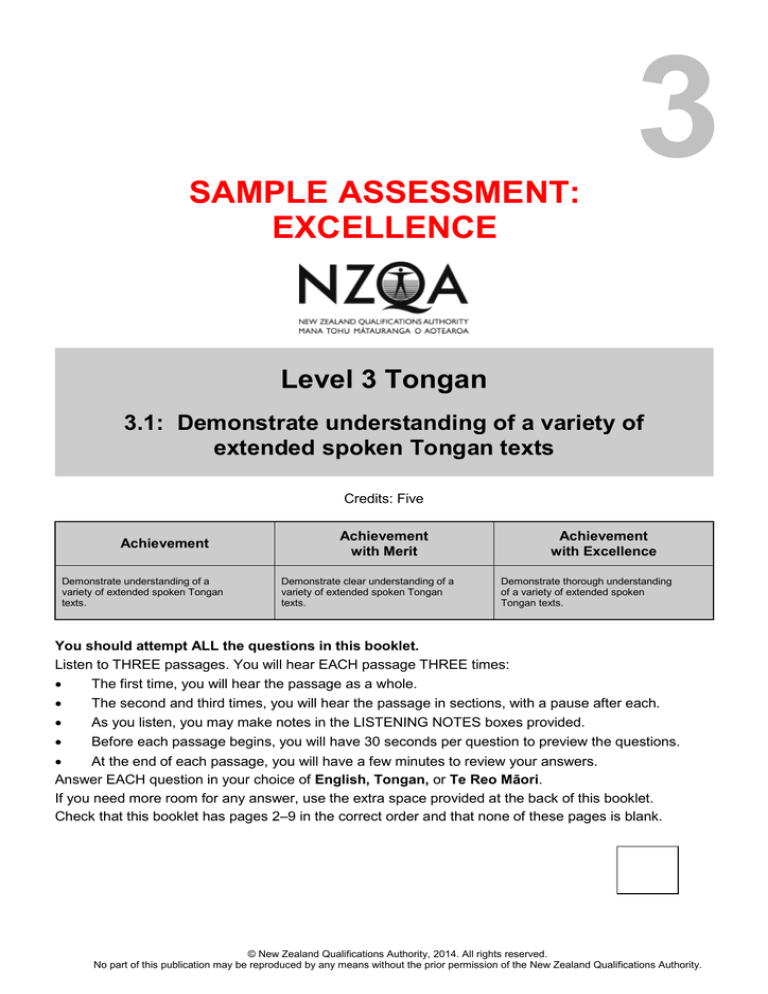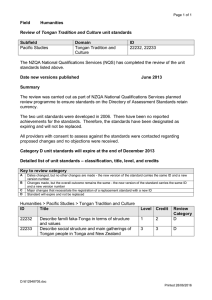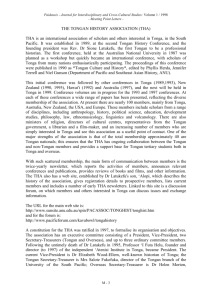
SAMPLE ASSESSMENT:
EXCELLENCE
3
Level 3 Tongan
3.1: Demonstrate understanding of a variety of
extended spoken Tongan texts
Credits: Five
Achievement
Demonstrate understanding of a
variety of extended spoken Tongan
texts.
Achievement
with Merit
Demonstrate clear understanding of a
variety of extended spoken Tongan
texts.
Achievement
with Excellence
Demonstrate thorough understanding
of a variety of extended spoken
Tongan texts.
You should attempt ALL the questions in this booklet.
Listen to THREE passages. You will hear EACH passage THREE times:
The first time, you will hear the passage as a whole.
The second and third times, you will hear the passage in sections, with a pause after each.
As you listen, you may make notes in the LISTENING NOTES boxes provided.
Before each passage begins, you will have 30 seconds per question to preview the questions.
At the end of each passage, you will have a few minutes to review your answers.
Answer EACH question in your choice of English, Tongan, or Te Reo Māori.
If you need more room for any answer, use the extra space provided at the back of this booklet.
Check that this booklet has pages 2–9 in the correct order and that none of these pages is blank.
© New Zealand Qualifications Authority, 2014. All rights reserved.
No part of this publication may be reproduced by any means without the prior permission of the New Zealand Qualifications Authority.
2
FIRST PASSAGE: Ko e lea fakaava ‘o e polokalama ‘Tākanga ‘etau
Fohe’
Ko e lea ‘eni ‘a e Faifekau Pule ‘o e siasi Metotisi Tonga ‘o Nu‘usila ni he fakaava ‘enau
polokalama ‘Tākanga ‘etau Fohe’ ma‘a e fānau, mātu‘a tauhi fānau mo e siasi.
Listen to the speech presented by the Superintendent of the Tongan Methodist Congregations of
New Zealand during the opening ceremony of their programme ‘Our Oars in Unison’ to support all
parties involved with educating children, such as parents and the church.
Ko e Fehu‘i ‘Uluaki (Konga A mo e Konga B) ‘oku fakatefito ia ‘i he konga tohi ko eni. ‘Oku ‘oatu
‘a e sekoni ‘e 30 ke ke lau ai ‘a e fehu‘i he taimi ni.
Question One (Section A and Section B) is based on this passage.
You now have 30 seconds to read the question.
FEHU‘I ‘ULUAKI – QUESTION ONE
Ngāue‘aki ‘a e Konga A ke tali ‘a e Fehu‘i ‘Uluaki (a) mo e (b).
Use Section A to answer Question One (a) and (b).
a) Ko e hā ‘a e taumu‘a ‘e ua ‘o e polokalama ‘Tākanga ‘etau Fohe’?
Describe the two main motivations behind the project ‘Our Oars in Unison’?
1. Ke faka‘ai‘ai mo fakalotolahi‘i ‘a e fānau ako, ke nau manako mo mahu‘inga‘ia he ako.
[To persuade and encourage students to love and value education.]
2. Ke faka‘ilo ki he mātu‘a ke nau ma‘u ‘a e taukei mo e poto fe‘unga ke teke mo muimui‘i e
ako ‘enau fānau. [To inform parents so they are able to gain experience and enough skills
to support and monitor the education of their children.]
b) Ko e hā ‘a e ‘uhinga kiate koe ‘a e ‘Tākanga ‘etau Fohe’?
What do you understand about the Tongan proverb ‘Our Oars in Unison’?
Ko e ‘Tākanga ‘etau Fohe’ ‘oku ‘uhinga ia ki he ngāue fakalukufua ‘a e siasi ke poupou‘i e
lotu, ako’ pea’ ke kau fakataha mo e lea mo hotau ‘ulungaanga faka-Tonga. [‘Our Oars in
Unison’ means united work by the people of the church to support worship, education,
language and our Tongan culture.]
Ngāue‘aki ‘a e Konga B ke tali ‘a e Fehu‘i ‘Uluaki (c) mo e (d).
Use Section B to answer Question One (c) and (d).
c) Ko e hā ‘a e ‘uhinga ‘oku tau ui ai ‘a Nu‘usila ni ko e ‘Fonua ‘o e hu‘akau mo e hone’?
Why do Tongan people call New Zealand ‘The land of milk and honey’?
Ko e fonua ni ‘oku mohu he ngaahi lelei kehekehe ‘o hangē ko e ako lelei, ngāue ‘oku vahe
lelei pea mo e mo‘ui ‘oku toe fakalakalaka ange. [This country has a lot of opportunities,
such as good education, employment that is well paid, and a better life that is progressive
in many aspects.]
Tongan 3.1 Sample assessment: Excellence
Ke
ngāue‘aki
pē ‘e he
faisivi
Assessor’s
use only
3
d) Ko e hā nai na‘e fakakaukau ai ‘a e Potungāue Ako ke nau fakahoko ‘a e lipooti ki he
Faifekau?
Why did the Ministry of Education forward the report to the Church Superintendent?
Na‘e ‘ikai ke a‘usia he‘enau fānau’ ha tu‘unga fakaako mā‘olunga na‘e faka‘amu ki ai ‘a e
mātu‘a ‘o e siasi’ fakatatau ki he ‘uhinga na‘a tau hiki fonua mai ai ki he fonua’ ni. [Our
children did not achieve high levels of educational success in the way parents of the
church had hoped in accordance with the purposes of our migration to this country.]
LISTENING NOTES
Tongan 3.1 Sample assessment: Excellence
Ke
ngāue‘aki
pē ‘e he
faisivi
Assessor’s
use only
4
SECOND PASSAGE: Ko e faka‘eke‘eke he TNews
Fanongo ki he faka‘eke‘eke ‘o e Palēmia ‘o Tonga fekau‘aki mo e tu‘unga ‘oku ‘i ai ‘a e
Pule‘anga Tonga, he‘ena pō talanoa pea mo Sētita Mila mei he TNews.
Listen to the interview with the Prime Minister of Tonga, by Sētita Mila from TNews.
Ko e Fehu‘i Ua (Konga A mo e Konga B) ‘oku fakatefito ‘i he konga tohi ko eni. ‘Oku ‘oatu ‘a e
sekoni ‘e 30 ke lau ai ‘a e fehu‘i he taimi ni.
Question Two (Section A and Section B) is based on this passage. You now have 30 seconds to
read the question.
FEHU‘I UA – QUESTION TWO
Ngāue‘aki ‘a e Konga A ke tali ‘a e Fehu‘i Ua (a) mo e (b).
Use Section A to answer Question Two (a) and (b).
(a) Ko e hā nai ha‘o lau ki he vā ‘o e feohi ‘a Nu‘usila ni pea mo Tonga?
Describe the relationship between New Zealand and Tonga.
Ko e vā ‘o Tonga mo Nu‘usila ni’ ‘oku fa‘a fakamāfana ‘aupito ‘ena fetokoni‘aki’ ‘i he ngaahi
founga kehekehe. [The relationship between Tonga and New Zealand is very close and it is
heartwarming seeing the way they help each other in different aspects of life.]
(b) Ko e hā nai ‘a e ngaahi ngāue ‘i Tonga na‘e tokoni lahi ki ai ‘a e pa‘anga tokoni ‘a Nu‘usila
ni? Hiki mai ha me‘a ‘e ua.
New Zealand’s financial aid to Tonga has supported many projects. List at least two of these
projects.
(1)
Ko e tokoni‘i ke toe fakalakalaka ange ‘a e ma‘u‘anga ‘uhila’. [To help further develop
electricity services.]
(2)
Ko e tokoni ke toe fakalakalaka ange ‘a e ngaahi ako’. [To help improve the quality of
schools.]
Ngāue‘aki ‘a e Konga B ke tali ‘a e Fehu‘i Ua (c).
Use Section B to answer Question Two (c).
(c) Ko e hā ‘a e vīsone ‘a e Palēmia ki he kakai ‘o Tonga?
What is the vision of the Prime Minister for Tonga?
Ko ‘ene vīsone ki he kaha‘u ‘o Tonga’ ke nau foki ‘o tō ‘a e ngoue’ mo fai ‘a e toutai’ mei
tahi he ko e ngaahi mata‘ikoloa ia ‘a Tonga’. [His vision for the future of Tonga is for
Tongans to cultivate crops and carry out fishing for these things are the treasures of
Tonga.]
Tongan 3.1 Sample assessment: Excellence
Ke
ngāue‘aki
pē ‘e he
faisivi
Assessor’s
use only
5
Ke
ngāue‘aki
pē ‘e he
faisivi
Assessor’s
use only
LISTENING NOTES
Tongan 3.1 Sample assessment: Excellence
6
THIRD PASSAGE: Tā ko e sola
Fanongo lelei ki he hiva ‘Tā ko e sola’.
Listen to the Tongan song ‘Tā ko e sola’.
Ko e fa‘u ‘eni ‘a Afuha‘amango ki he La‘ā kuo unga fonua – Tāufa‘āhau Tupou IV ‘i he hili ‘ene
mā‘imoa ako mei muli pea ne ma‘u ai hono faka‘ilonga mata‘itohi he ako ko e BA pea mo e LLB.
Tongan composer Afuha‘amango wrote this song to mark the graduation of the late King
Tāufa‘āhau Tupou IV when he graduated from university with a BA and LLB.
Ko e Fehu‘i Tolu (Konga A mo e Konga B) ‘oku fakatefito ‘i he konga tohi ko eni. ‘Oku ‘oatu ‘a e
sekoni ‘e 30 ke lau ai ‘a e fehu‘i he taimi ni.
Question Three (Section A and Section B) is based on this passage. You now have 30 seconds to
read the question.
FEHU‘I TOLU – QUESTION THREE
(a) Ko e hā nai ‘a e taumu‘a na‘e fa‘u ki ai ‘a e hiva ni?
What was the theme of the song?
Na‘e fa‘u ‘a e hiva’ ni ki he mā‘imoa ako ‘a e La‘ā kuo unga fonua’ tama, Tu‘i ko Taufa ‘āhau
Tupou IV he ikuna hono faka‘ilonga mata‘itohi ko e BA/LLB. [This song was composed
about the educational achievements of the late King, His Majesty King Tāufa’āhau Tupou
IV, when he gained his BA/LLB degrees.]
(b) Ko e hā nai na‘e ngāue‘aki ai ‘e he punake ‘a e ngaahi fo‘i lea Tonga ko ‘eni he‘ene fa‘u ‘a e
hiva?
Why did the composer use the following words in the song?
Sola / stranger (in line one, stanza one)
Ko ha taha ‘oku hā fo‘ou ki ha feitu‘u. [Someone who newly appears at a place.]
Tumutumu / top of the mountain (in line three, stanza one)
Ko e taupotu taha ki he langilau’. [Uppermost in achievement.]
Viki / proudly talk about something (in line two, final stanza)
Ko e fakalāngilangi‘i. [Praising, eulogising.]
Tongan 3.1 Sample assessment: Excellence
Ke
ngāue‘aki
pē ‘e he
faisivi
Assessor’s
use only
7
Ke
ngāue‘aki
pē ‘e he
faisivi
Assessor’s
use only
LISTENING NOTES
Tongan 3.1 Sample assessment: Excellence
8
Konga ‘oku ‘atā ‘o ka fiema‘u.
Extra space if required.
Tohi ‘a e fika ‘o e fehu‘i ‘o ka fiema‘u.
Write the question number(s) if applicable.
Fika ‘o e
fehu‘i
Question
number
Tongan 3.1 Sample assessment: Excellence
Ke
ngāue‘aki
pē ‘e he
faisivi
Assessor’s
use only
9
Konga ‘oku ‘atā ‘o ka fiema‘u.
Extra space if required.
Tohi ‘a e fika ‘o e fehu‘i ‘o ka fiema‘u.
Write the question number(s) if applicable.
Fika ‘o e
fehu‘i
Question
number
Tongan 3.1 Sample assessment: Excellence
Ke
ngāue‘aki
pē ‘e he
faisivi
Assessor’s
use only




